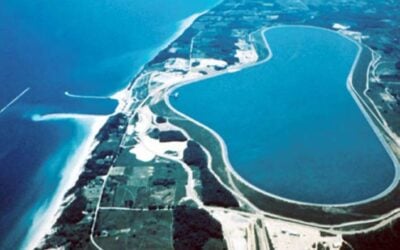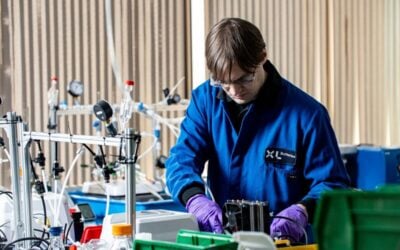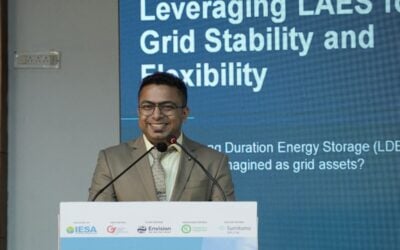
Iron flow battery company ESS Tech Inc (ESS Inc) has warned of substantial doubts about its ability to survive another year.
The Oregon, US-headquartered technology company, which holds the IP for a proprietary flow battery based on iron and saltwater electrolyte aimed at long-duration energy storage (LDES) applications, reported its latest quarterly financial results last week (14 August).
The company reported Q2 2025 revenue of US$2.4 million, a 578% increase year-on-year from just US$300,000 in Q2 2024 and a 294% increase from US$600,000 in Q1 of this year.
However, while it has been able to reduce GAAP cost of revenues by 15% since last year, and GAAP operating expenses by 35% quarter-over-quarter, at US$7.5 million and US$6.5 million respectively for Q2, ESS Inc reported US$11.6 million loss from operations, US$-7.8 million adjusted EBITDA and US$0.90 net loss per share.
Try Premium for just $1
- Full premium access for the first month at only $1
- Converts to an annual rate after 30 days unless cancelled
- Cancel anytime during the trial period
Premium Benefits
- Expert industry analysis and interviews
- Digital access to PV Tech Power journal
- Exclusive event discounts
Or get the full Premium subscription right away
Or continue reading this article for free
As with other players in the emerging non-lithium energy storage space, ESS Inc. has been banking on growth in demand for LDES, coupled with its ability to reduce costs as it increases scale and automation of manufacturing.
It also seeks to differentiate itself from other flow battery providers, arguing that the iron electrolyte solution is non-toxic, unlike the vanadium pentoxide dissolved in sulfuric acid used in most commercially available flow battery systems.
The company’s shares were listed on the New York Stock Exchange (NYSE) in 2021, as part of a wave of energy storage tech startups to go public between 2020 and around 2023 via special purpose acquisition company (SPAC) mergers.
Since then, its share price has plummeted from an all-time high of US$281.25 just after it listed in November 2021, to US$1.74 as markets closed on Friday, 15 August.
CEO: Company aims for ‘sharper focus, disciplined execution and a stronger financial foundation’
ESS Inc leadership had warned, as it went public, that profitability may remain some way off, but persistent challenges led to a recent “operational reset,” as acting CEO Kelly Goodman said in remarks to accompany the latest results release.
It is currently pivoting to a new product line, Energy Base, aimed at providing very large capacities of 12-hour to 14-hour long-duration storage to customers that could include data centres and large-scale renewable energy operators. It is effectively discontinuing its two legacy products, Energy Center and Energy Warehouse, aimed at applications requiring up to 12-hour duration.
As such, CFO Tony Robb had said in Q1’s results release in May that revenues from Energy Base would not be recognised until 2026, but could lead to the company achieving profitability in the next few years if the product is a success.
ESS Inc said the first Energy Base sale closed during Q2, and the company submitted proposals for over 1.1GWh of projects in the three-month period.
Interim CEO Goodman claimed that Q2’s results represented the early results of the company’s “operational reset” and that ESS Inc is “building a business with sharper focus, disciplined execution, and a stronger financial foundation.”
‘Substantial doubts’ around next 12 months voiced in 10-K
Despite this early market traction and despite a US$31 million financing injection secured last month, the company warned in its Form 10-K filed with the US Securities and Exchange Commission (SEC) that it requires additional debt or equity financing.
Anticipating that losses will continue in the near term, ESS Inc. said that the potential inability to meet near-term operating cash flow requirements means that “substantial doubt exists as to our ability to continue as a going concern” for 12 months from the issuance of the 10-K.
The flow battery player ended Q2 2025 with US$800,000 unrestricted cash and cash equivalents.
The latest warning comes after the company implemented cost-cutting measures, including furloughing a “substantial number of employees” at the end of May, minimising spending, and focusing R&D efforts on Energy Base.
The change in strategy has resulted in changes in leadership too. Long-serving CEO Eric Dresselhuys stepped down in February to make way for Goodman, while this week the company also announced interim replacements for its COO and CFO.
The good news on the financial front is that, in addition to the growth in revenue, losses have narrowed significantly year-on-year, from a US$22 million net loss in Q2 2024 to US$11 million in the quarter just gone. The company has also reduced its cash burn rate by 80% compared to Q1 2025.
As with fellow publicly listed non-lithium electrochemical LDES startup Eos Energy Enterprises in its recent results release, ESS Inc. leadership played up the potential value in being able to serve US markets with products compliant with domestic content rules, including the newly introduced Foreign Entity of Concern (FEOC) provisions for tax credit eligibility.





